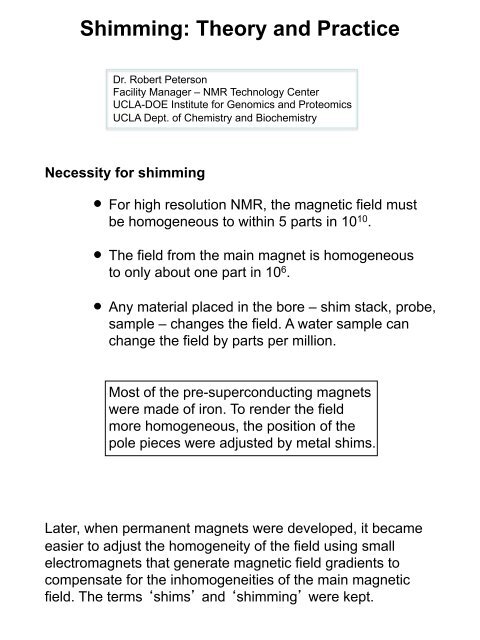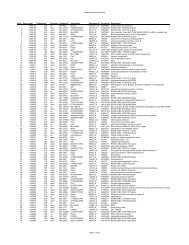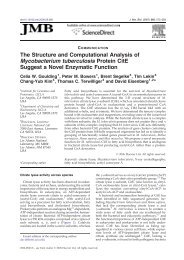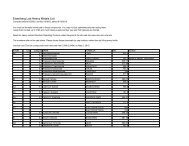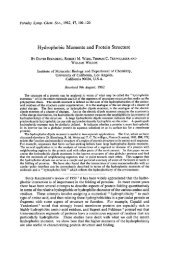Shimming: Theory and Practice - UCLA-DOE
Shimming: Theory and Practice - UCLA-DOE
Shimming: Theory and Practice - UCLA-DOE
You also want an ePaper? Increase the reach of your titles
YUMPU automatically turns print PDFs into web optimized ePapers that Google loves.
<strong>Shimming</strong>: <strong>Theory</strong> <strong>and</strong> <strong>Practice</strong><br />
Dr. Robert Peterson<br />
Facility Manager – NMR Technology Center<br />
<strong>UCLA</strong>-<strong>DOE</strong> Institute for Genomics <strong>and</strong> Proteomics<br />
<strong>UCLA</strong> Dept. of Chemistry <strong>and</strong> Biochemistry<br />
Necessity for shimming<br />
For high resolution NMR, the magnetic field must<br />
be homogeneous to within 5 parts in 10 10 .<br />
The field from the main magnet is homogeneous<br />
to only about one part in 10 6 .<br />
Any material placed in the bore – shim stack, probe,<br />
sample – changes the field. A water sample can<br />
change the field by parts per million.<br />
Most of the pre-superconducting magnets<br />
were made of iron. To render the field<br />
more homogeneous, the position of the<br />
pole pieces were adjusted by metal shims.<br />
Later, when permanent magnets were developed, it became<br />
easier to adjust the homogeneity of the field using small<br />
electromagnets that generate magnetic field gradients to<br />
compensate for the inhomogeneities of the main magnetic<br />
field. The terms shims <strong>and</strong> shimming were kept.
Mathematical Analysis<br />
Taken from:<br />
Concepts in Magnetic<br />
Resonance (1990), 2 131-149<br />
Any steady-state magnetic field in a volume of space in which there are<br />
no charges or current obeys the Laplace equation:<br />
The field can be represented as a linear combination of any complete,<br />
orthogonal basis set. The spherical harmonics are a convenient basis<br />
set for this purpose. Thus, B 0 is described by the expansion in spherical<br />
harmonics:<br />
Where a is the average bore radius, r represents the sample position, <strong>and</strong><br />
C nm <strong>and</strong> Ψ nm are constants.<br />
The calculations are easier<br />
when performed in spherical<br />
polar coordinates.<br />
Since the sample volume is small compared to the bore size, as the order<br />
(n) Gets higher, (r/a) n becomes negligible. Good thing too because the<br />
Number of terms in this equation is infinite, <strong>and</strong> we would need infinitely<br />
Many shims!
The functions P nm (cosθ) are polynomials in cosθ, <strong>and</strong> when m=0,<br />
P n0 are the Legendre Polynomials.<br />
The first few Legendre Polynomials<br />
Notice that all variation of B 0 with Φ disappears when m=0 because<br />
the final cosine term is unity. When m=0 the functions in the equation<br />
for B 0 are called zonal harmonics, <strong>and</strong> the zonal field is given by:<br />
You can think of these as the Z components of the field. That is,<br />
inhomogeneities that can be canceled by Z shims.
The harmonics for which m is not zero are called the tesseral harmonics.<br />
note that because of the final cosine term, as we move in a circle around<br />
the Z axis (as in a spinning sample), the field oscillates at harmonics of<br />
the rotation frequency.<br />
When m is not zero, the functions P nm (cosθ) are called the Associated<br />
Legendre Polynomials:<br />
Some of the Associated Legendre Polynomials<br />
This separation of harmonics into zonal <strong>and</strong> tesseral is important when<br />
the sample is spinning. The tesseral harmonics are, of course, related to<br />
the off-axis shims.<br />
Of all the terms the equation for B 0 , only the one where n=m=0 represents<br />
a homogeneous field. For our purposes, all the others are error terms that<br />
describe the inhomogeneities of the field.
Modern shims are coils that produce extra fields that can cancel the unwanted<br />
harmonics in B 0 . The shim coils are designed to produce, when current is<br />
passed through them, a single harmonic. Then the current in that shim can be<br />
adjusted to exactly cancel that portion of the inhomogeneity described by that<br />
particular spherical harmonic.<br />
Shims are usually labeled in Cartesian coordinates. The conversion from<br />
spherical coordinates is tedious, but its just algebra. For example, the 3,1<br />
harmonic shim is:<br />
The common name for this shim is xz 2 .<br />
Cartesian representation of spherical harmonics:<br />
Because of the phase term (Ψ nm ) in the B 0 equation, the phase of the tesseral<br />
shims must be adjustable. This could be accomplished by making the shims<br />
rotatable. Whats done in practice is to make them in pairs. So for each<br />
tesseral shim we have separate X (cos) <strong>and</strong> Y (sin) shims.
In a perfect world, each shim coil would generate exactly one harmonic.<br />
then shimming would be a simple process of going through all the shims<br />
one time <strong>and</strong> maximizing each one.<br />
In reality, due to design compromises <strong>and</strong> winding errors, each shim coil<br />
generates several harmonics <strong>and</strong> the shims interact.<br />
An example of how the shims get mixed:<br />
Imagine we had only z <strong>and</strong> z 2<br />
shims.<br />
In this example the center of the<br />
RF coil is above the center of the<br />
shim set.<br />
If the initial error in the field is<br />
ΔB 0 =a+bz-cz 2 , <strong>and</strong> the operator<br />
first tries increasing z 2 , the field<br />
will get worse (b). Decreasing<br />
z 2 reduces the inhomogeneity (c)<br />
but the field is clearly not<br />
homogeneous so the lineshape<br />
will be poor.<br />
In this example, the correct<br />
procedure would have been to<br />
increase z 2 as in (b), then<br />
decrease z until the field was<br />
homogeneous.<br />
This illustrates why there are local maxima, <strong>and</strong> why one often has to move a<br />
shim so that the lock level decreases to find a higher maximum.
Since the sample is not centered at z=0, but at z=z 0 , z becomes (z + z+ 0 )<br />
<strong>and</strong> ΔB 0 =cz 2 becomes:<br />
ΔB 0 =c(z + z 0 )2 = c(z 2 + 2zz 0 + z 02 )<br />
Z 0 is a constant, so 2zz 0 is linear, <strong>and</strong> the z 2 shim has a z component.<br />
Many other flaws can lead to this sort of thing. Design or manufacturing<br />
flaws in the shim coils, shim coils not perfectly positioned, etc, all<br />
contribute to mixing of shims. If you extrapolated this example to three<br />
dimensions <strong>and</strong> 28 shims (on our systems), you can see why shimming<br />
is so difficult.<br />
Manual <strong>Shimming</strong><br />
Once a particular probe in a particular magnet is shimmed, most of the shims<br />
dont need adjustment from sample to sample. Its primarily the z shims that<br />
change.<br />
Why? The radial extent of our samples is very small <strong>and</strong> theyre quite radially<br />
symmetric. Also theres very little radial change from sample to sample. In<br />
contrast, the samples are quite long in the z direction so the shimming is<br />
more important (<strong>and</strong> harder). And theres a lot of variation in length <strong>and</strong><br />
centering from sample to sample.<br />
Although each shim produces several harmonics, making life miserable for<br />
the shimmer, each shim is contaminated by lower order shims of the same<br />
parity (z 3 is mostly contaminated by z, <strong>and</strong> z 4 by z 2 , etc). This makes it easier<br />
to find effective shimming strategies.
To shim well, one must look at the FID <strong>and</strong>/or the spectrum, not just the<br />
lock level. Getting an idea what these indicators look like when certain<br />
shims are off is very helpful. Here are some examples with the z shims:<br />
Good shimming Z shim off<br />
When the z shim is off, the initial decay of the FID is much faster <strong>and</strong> can<br />
have beats. The spectrum broadens <strong>and</strong> manifests structure.<br />
Here what look like individual peaks within the single peak are due to B 1<br />
(the field generated by the pulse) inhomogeneities. Local maxima in B 1<br />
close to probe coil conductors cause these peaks.
As we misset shims of higher order, the initial fall off of the FID gets faster:<br />
z 2 shim misset in one direction (a), <strong>and</strong> in the other (b)<br />
Even orders give a hump on one side of the peak. Why?<br />
Z 2 is an even function:<br />
There is much sample volume in<br />
the vicinity of field strength A.<br />
This gives rise to the main peak.<br />
At higher field (like at B) there is<br />
some sample (this gives rise to<br />
the hump), <strong>and</strong> there is no<br />
field lower than A so theres a<br />
sharp cutoff on one side. The<br />
hump ends suddenly because<br />
the sample tube ends.<br />
For higher orders the hump is lower on the peak but has a longer tail.
z 3 set incorrectly<br />
In this case, the z 3 shim is contaminated with z <strong>and</strong> z 2 .<br />
z 4 set incorrectly<br />
Note that the asymmetric hump is much lower on the peak that<br />
It was when z 2 was misset.
<strong>Shimming</strong> the higher order z shims:<br />
In order to shim z 4 , you must first optimize z-z 3 . Then change z 4 in one<br />
direction or the other so as to degrade the lock response somewhat. I usually<br />
move it 1000 or 2000 units.<br />
**If moving z 4 initially makes the lock rise, thats probably the right direction.<br />
Then reshim z-z 3 <strong>and</strong> see if the shimming is better than it was with the<br />
original value of z 4 .<br />
IMPORTANT! Dont just look at the lock. Carefully examine your spectrum or<br />
FID <strong>and</strong> decide whether it has improved or not. Specifically focus on the<br />
effect of misset z 4 (i.e. an asymmetric hump low on the peak). If the hump is<br />
coming in, that should be the right direction, even if the lineshape is worse in<br />
other ways. If your sample is in water, you must evaluate the shims using a 1D<br />
presaturation experiment. Without presaturation, the water line is too broad to<br />
see the asymmetries from poor shimming.<br />
If the lineshape gets worse<br />
in that direction, try the<br />
optimal<br />
other direction. If youre lineshape<br />
careful, you should get<br />
something like this:<br />
z 4<br />
After z 4 is optimized, if the lineshape still looks poor, <strong>and</strong> specifically if it looks<br />
like z 5 might be off (symmetric broadening very low on the peak), then you<br />
must optimize z 5 in the same way. In principle, every time you change z 5 , you<br />
should reoptimize z 4 as above, in practice the process can usually be<br />
shortened by paying close attention <strong>and</strong> getting a feel for which way the<br />
shims are moving.<br />
Z 6 is shimmed the same way. But usually its not necessary. Usually Z 6 should<br />
be left alone. Also – gradient shimming doesnt h<strong>and</strong>le z 6 well, so dont include it<br />
in your shim group.
Off-Axis <strong>Shimming</strong><br />
As mentioned above, the off-axis, or tesseral, shims dont change too much<br />
from sample to sample. Usually its sufficient to just shim on the lock. I work<br />
my way up from low order shims (x, y) to high order shims (xz 4 , yz 4 , xyz 3 ,<br />
(x 2 -y 2 )z 3 , x 3 z, y 3 z) <strong>and</strong> then back down, working in complementary pairs (i.e.<br />
xz <strong>and</strong> yz), <strong>and</strong> iterating between shims of the same order.<br />
If you need to shim the off axis shims really well, you should spin the sample.<br />
If the sample is spun at 20Hz, <strong>and</strong> a first order tesseral shim is misset,<br />
spinning sideb<strong>and</strong>s at +/- 20Hz will appear in the spectrum. This is because<br />
each volume element will return to a particular field strength once per<br />
revolution.<br />
Effect of incorrect x or y shim with sample spinning at 20 Hz:<br />
Since the modulation is 20Hz, this tells you that the degree of the shim that<br />
needs adjusting is 1, but it doesnt tell you which shim(s) is responsible. x, y,<br />
xz, yz, xz 2 , etc are all possible.<br />
When the sample is spun, the zonal <strong>and</strong> tesseral inhomogeneities are<br />
separated out. The tesseral inhomogeneity determines the depth of the<br />
modulation <strong>and</strong> the size of the sideb<strong>and</strong>s, while the zonal inhomogeneity<br />
controls the overall shape <strong>and</strong> duration of the FID <strong>and</strong> the lineshape.
Effect of 2,2 (xy or x 2 -y 2 ) inhomogeneity with sample spinning at 20 Hz:<br />
Now the spinning sideb<strong>and</strong>s are at +/- 40Hz because each volume<br />
element will pass through a given field strength twice per revolution.<br />
This is quite useful in shimming because it narrows down the shims that<br />
need adjusting. Of course there are problems with this as well:<br />
Less than 20% modulation of the FID gives mostly m th degree<br />
spinning sideb<strong>and</strong>s, but more than this (if a shim is really far<br />
off) gives sideb<strong>and</strong>s at integer multiples of the spinning<br />
frequency. So it can be confusing. You best bet is to work on<br />
lowest degree (in x <strong>and</strong> y) shims first, then move to higher<br />
degree shims.<br />
Even in a perfectly homogeneous B 0 field, B 1 inhomogeneity<br />
can produce spinning sideb<strong>and</strong>s
A <strong>Shimming</strong> Procedure<br />
Before you start shimming there are a few things you should always do.<br />
Make sure your sample is at the right depth – centered if its a short<br />
sample or in a Shigemi tube, 21mm otherwise (depending on the probe).<br />
Start from good shims. Read in a previously saved shim file <strong>and</strong> make<br />
sure its from the same probe you are using.<br />
Always lock it with lock D 2 O/H 2 O. This sets the loop gain, loop filter, <strong>and</strong><br />
loop time <strong>and</strong> the lock power. After you do this once you can lock <strong>and</strong><br />
unlock it manually.<br />
Unlock the spectrometer <strong>and</strong> adjust the lock phase. You should also<br />
check this sometimes during the shimming process because changes in<br />
the shims can change the lock phase.<br />
Carefully adjust the lock power so its as high as it can be without<br />
saturating. -17 for water <strong>and</strong> -25 should be close.<br />
Shim z, z 2 , <strong>and</strong> z 3 first, carefully <strong>and</strong> iteratively. Often you can pull a lot more<br />
out of these than you would think.<br />
Shim the lower order off axis shims from lowest to highest <strong>and</strong> back. For<br />
Example, shim (x, y) (xz, yz, (x 2 -y 2 ), xy) <strong>and</strong> (xz 2 , yz 2 , (x 2 -y 2 )z, xyz). Then<br />
(xz, yz, (x 2 -y 2 ), xy) <strong>and</strong> (x, y). Iterate between all the ones in parentheses. In<br />
particular remember that if a higher order shim changes (e.g. xz 2 ), you must<br />
reshim the lower orders of the degree (xz <strong>and</strong> x, <strong>and</strong> also yz <strong>and</strong> y).<br />
Reshim z, z 2 , <strong>and</strong> z 3 . If there are changes, you might check the low order<br />
off axis shims again, then reshim z, z2, <strong>and</strong> z3. Up until now, all the<br />
shimming has been on the lock.
Now look at the spectrum <strong>and</strong> evaluate the shimming (remember that you must<br />
use a presaturation experiment for water samples). If necessary, shim z4<br />
<strong>and</strong> z5 as described above. If the z shims change significantly, redo the off<br />
axis shims <strong>and</strong> z – z 3 .<br />
In most cases this is all you need to do to get a good shim. If all of this doesnt<br />
yield a decent lineshape, go to the higher order off axis shims. Keep trying! A<br />
lot of good shimming is attitude.<br />
Of course its possible theres a real problem. One of the cryoshims might<br />
have quenched. Is there a large piece of metal hanging from the bottom of the<br />
magnet? Is the magnet tilted?<br />
Theres no right way to shim.<br />
No two people do it exactly<br />
the same way. Heres another<br />
shimming procedure from the<br />
Protein NMR Spectroscopy<br />
book.<br />
This is a complete shimming<br />
procedure, but theyre only<br />
using 17 shims while our<br />
systems have 28. You can<br />
extrapolate to the higher order<br />
shims <strong>and</strong> use this procedure<br />
to shim on our systems.
NMR Imaging <strong>and</strong> Gradient <strong>Shimming</strong><br />
A short description of NMR imaging<br />
Applying a gradient across a sample during an NMR experiment<br />
translates spatial information into frequency information:<br />
G z<br />
Z gradient applied<br />
during acquisition<br />
NMR sample<br />
with plastic plug<br />
FID – overlap of many frequencies<br />
FT<br />
The spectrum is a<br />
1D image of the<br />
Sample.<br />
frequency<br />
Lauterbur, P.C.<br />
Nature 242 (1973) 190-191
Fourier Imaging<br />
Increment #<br />
1<br />
strength<br />
of G y<br />
0<br />
G y<br />
G z<br />
2<br />
1<br />
2D imaging – YZ plane<br />
Several experiments are done.<br />
G y strength is incremented.<br />
3<br />
2<br />
4<br />
3<br />
Frequency during acquisition<br />
determines position along<br />
z-axis.<br />
Y<br />
Change in phase with<br />
incremental change in G y<br />
determines position along<br />
y-axis.<br />
Z<br />
Kumar, Welti, <strong>and</strong> Ernst<br />
JMR 18 (1975) 69-83
Gradient <strong>Shimming</strong><br />
from:<br />
J. Magn. Reson. A (1994), 111, 203-207<br />
A phase image of the sample reflects the evolution of the magnetization.<br />
When the carrier is on resonance, the phase difference Δφ(r) obtained at a<br />
certain position in the sample from images taken at two echo times (TE) is<br />
determined by the field inhomogeneity γΔΒ(r):<br />
Δφ(r) = γΔΒ(r)[TE 1 – TE 2 ]<br />
The effect of the shims can be similarly mapped by measuring the phase<br />
difference between images at two different shim settings:<br />
γ[ΔΒ(r) shimset 1 - γ[ΔΒ(r) shimset 2 ] = [Δφ shimset 1 (r) - Δφ shimset 1 (r)] / [TE 1 – TE 2 ]<br />
Optimum shim settings can then be calculated using the measured field<br />
inhomogeneity, <strong>and</strong> the known effects of each shim.
1D image of field inhomogeneity<br />
a<br />
b<br />
c<br />
G z<br />
τ τ τ <br />
0<br />
3<br />
+10<br />
-10<br />
1D gradient echo<br />
experiment<br />
2<br />
-5 0 0<br />
1<br />
-10 -10 +10<br />
region<br />
of sample<br />
inhomogeneous sample 1 st gradient readout<br />
field<br />
gradient<br />
1<br />
a<br />
y<br />
b<br />
c<br />
acq<br />
x<br />
freq. = -10<br />
2<br />
b<br />
c<br />
acq<br />
freq. = -5<br />
3<br />
b<br />
c<br />
acq<br />
freq. = 0
a<br />
b<br />
1D image of field inhomogeneity<br />
c<br />
0<br />
3<br />
+10<br />
-10<br />
G z<br />
τ 3τ τ <br />
1D gradient echo experiment<br />
with longer echo time<br />
2<br />
-5 0 0<br />
1<br />
-10 -10 +10<br />
inhomogeneous sample 1 st gradient readout<br />
field<br />
gradient<br />
region<br />
of sample<br />
1<br />
a<br />
y<br />
b<br />
c<br />
acq<br />
x<br />
phase difference<br />
= -90 degrees<br />
freq. = -10<br />
2<br />
b<br />
c<br />
acq<br />
phase difference<br />
= -45 degrees<br />
freq. = -5<br />
3<br />
b<br />
c<br />
acq<br />
no phase difference<br />
freq. = 0
Phase difference<br />
-90 -45 0<br />
1 2 3<br />
Image of the field<br />
When the carrier is on resonance, the phase difference Δφ(r) obtained<br />
at a certain position in the sample from images taken at two echo times<br />
is determined by the field inhomogeneity ΔΒ(r).<br />
Δφ(r) = γΔΒ(r)[TE 1 – TE 2 ]<br />
An image of the field is made by plotting the phase difference<br />
divided by the echo time difference against frequency.<br />
(remember that because of the acquisition gradient, frequency<br />
corresponds to position in the sample)
Field Mapping<br />
The field correction provided by the shims for a given change in<br />
shim current can be mapped similarly.<br />
The phase difference between images at two different shim settings<br />
is measured:<br />
γ[ΔB(r) shimset 1 – ΔB(r) shimset 2 ] = [Δφ shimset 1 (r) – Δφ shimset 2 (r)]/[TE 1 -TE 2 ]<br />
Therefore to map the shims, an image of the field is generated once<br />
with reasonable shims. Then a shim is moved significantly <strong>and</strong><br />
another image is taken. This shim is returned to its original value. This<br />
is done with each shim in turn.<br />
The 1D field maps generated by missetting<br />
individual shims look something like this:<br />
Z<br />
Z 2<br />
etc
3D images <strong>and</strong> field mapping<br />
G z<br />
G x,y<br />
3D images can be done by<br />
performing many 1D scans,<br />
incrementing the strength (or<br />
length) of the X <strong>and</strong> Y gradients<br />
in a nested fashion.<br />
Each 3D experiment takes almost 2 minutes, so each 3D image<br />
takes almost 4 minutes to acquire (2 experiments are necessary,<br />
using two different echo times).<br />
You can see that 3D field mapping takes awhile. To map all 28 shims,<br />
58 experiments must be run (2 + 2[28]).<br />
The field maps are empirical maps of the real effects of the shims.
Gradient <strong>Shimming</strong><br />
When gradshim is executed, an image (1D or 3D) is taken of the<br />
field using two echo delays (TE 1 <strong>and</strong> TE 2 ) as before.<br />
The image is compared to the field maps, <strong>and</strong> the computer calculates<br />
how best the change the shims to make the field homogeneous.;<br />
Heres how the calculation is done:<br />
Optimal shim settings are calculated by solving the following<br />
least-squares problem using singular value decomposition:<br />
S opt = arg. min. (||A . s – b|| 2 )<br />
where<br />
A = matrix of n column vectors, each one a vector of field changes per<br />
unit shim change for m spatial positions. n is the number of shims.<br />
b = vector of current field values for m spatial elements<br />
s = vector of n starting shim settings<br />
S opt = optimal shim settings
Heres a simple example: 1 shim (z), 3 spatial positions<br />
a 1 a 1 z 1<br />
a 2 z 1 = a 2 z 1<br />
a 3 a 3 z 1<br />
A<br />
s<br />
a 1 z 1 – b 1<br />
a 2 z 1 – b 2<br />
a 3 z 1 – b 3<br />
To get the optimal shim settings, the square<br />
of this vector must be minimized.<br />
A . s - b<br />
Bruker uses 128x32x32 points (that is: 32 increments in each of the G x<br />
<strong>and</strong> G y dimensions, <strong>and</strong> 128 points in the acquisition) with a field of view<br />
of 28x6.4x6.4 mm.<br />
So there are 131,072 voxels, roughly 35,000 of which are contained in<br />
the sample.<br />
Each of these volume elements is 8.8 x 10 -9 liters.
Topshim<br />
Topshim is essentially gradient shimming using a better<br />
algorithm. In principle it achieves a better shim than gradshim,<br />
<strong>and</strong> it does it faster.<br />
The main difference is that everything is automatic. The<br />
program decides which shims to use, determines the best<br />
length of sample, <strong>and</strong> iterates until the shimming is optimized.<br />
It even comes with built-in field maps.<br />
Basic usage:<br />
topshim:<br />
topshim 3d:<br />
automatically performs 1D gradient shimming.<br />
automatically performs 3D gradient shimming.<br />
topshim gui: opens the graphical user interface. From the gui<br />
you can start topshim with many different options.<br />
There are dozens of parameters <strong>and</strong> options. Their use is<br />
covered in the Topshim manual (available under the help<br />
menu in Topspin). All are accessible from the GUI or the<br />
comm<strong>and</strong> line.<br />
To successful shimming with Topshim, always do these two<br />
things first:<br />
1) Open the data set of the planned NMR experiment.<br />
2) Lock the sample for the correct solvent using the lock<br />
comm<strong>and</strong>. Topshim optimizes things differently for each lock<br />
solvent. Note in particular that the shimming methods for D2O<br />
<strong>and</strong> H2O+D2O are different.
Spectrum Optimization<br />
Topshim performs an optimization of some criterion for the quality<br />
of the spectral line. There are four options:<br />
ls lineshape with narrow width (default for D2O)<br />
lshump lineshape with narrow hump<br />
ss solvent suppression (default for H2O+D2O)<br />
optoff no optimization, use st<strong>and</strong>ard spatial weighting<br />
These can be invoked from the comm<strong>and</strong> line or from the GUI.<br />
Example: topshim 3d lshump<br />
Tune<br />
Sometimes its helpful to remove residual shim gradients after<br />
gradient shimming. This can be done using the tune option in<br />
Topshim. It just maximizes the lock level using a subset of the<br />
shims. It can also be done just before gradient shimming. This can<br />
be useful, for example, to prepare the best off-axis shims before<br />
running 1D gradient shimming.<br />
For example:<br />
topshim tunebxyz tuneaz: this tunes Z, X, <strong>and</strong> Y before <strong>and</strong> after<br />
1D gradient shimming.<br />
topshim tune tunea: this tunes Z, X, Y, XZ, <strong>and</strong> YZ <strong>and</strong> does no<br />
gradient shimming at all.


